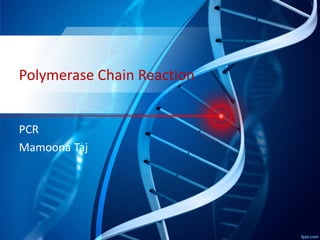
PCR.pdf
- 2. PCR /DNA amplification • A means to amplify a particular piece of DNA • Amplify is making numerous copies of a segment of DNA • Its applications are vast and PCR is now an integral part of Molecular Biology
- 3. DNA Replication vs PCR PCR is laboratory version of DNA replication in cells The laboratory version is commonly called “in vitro” since it occurs in test tubes while “in vivo” signifies occurring in a living cell
- 4. Principle • The PCR involves the primer mediated enzymatic amplification of DNA. PCR is based on using the ability of DNA polymerase to synthesize new strand of DNA complementary to the offered template strand.
- 5. Introduction • PCR, polymerase chain reaction, is an in-vitro technique for amplification of a region of DNA whose sequence is known or which lies between two regions of known sequence • Widely used method to make many copies of a specific DNA segment • DNA sequences are exponentially amplified to generate thousands to million more copies of particular DNA segment
- 6. 1966 Thomas D. Brock (age 92y) an American microbiologist discovered Thermus aquaticus a thermostable bacteria in the hot springs of Yellowstone National Park
- 7. 1983 Kary Banks Mullis died 7 August 2019 (aged 74y) a Nobel Prize winning American botanist postulated the concept of PCR
- 8. 1985 Saiki published the first application of PCR (beta-Globin) Cetus corporation scientists isolated Thermostable Taq polymerase from Thermus aquaticus which revolutionized PCR
- 9. Five Components needed to perform PCR in laboratory ➢ DNA template (Your DNA of interest that contains the target sequence you wish to copy) ➢ Taq Polymerase (A heat stable DNA polymerase) ➢ Primers (Two short single stranded DNA molecules) ➢ dNTPs (All four nucleotide triphosphates) ➢ Buffers (To ensure right conditions in the reaction) ➢ Mg2+ ➢ Thermal Cycler (A device that can change temperatures dramatically in a very short period of time )
- 10. Thermal Cycler
- 11. PCR Tubes
- 13. 1. DNA template • DNA containing region to be sequenced • Size of the target DNA to be amplified up to 3 Kb ( A kilo base (kb) is a unit of measurement in molecular biology equal to 1000 base pairs of DNA or RNA.)
- 14. 2. Primers • Short pieces of single stranded DNA • Generally 20-30 nucleotides long • Synthetically produced • Complementary to the 3/ end of the target DNA • Not complementary to each other • Forward Primer and Reverse Primer
- 16. 3. Heat stable DNA Polymerase • Usually Taq polymerase • Optimum temperature for activity is 75ºC-80ºC • Taq DNA polymerase was purified from the hot springs bacterium Thermus aquaticus in 1976 • Substantially reduced activity at lower temperatures • High proccessivity
- 18. The PCR Cycle • Consist of three steps Denaturation Annealing Extension • To amplify the target DNA PCR steps are cycled or repeated many times.
- 19. Denaturation • At 95ºC the DNA is denatured • The high temperature causes the hydrogen bondsbetween the bases in two strands of template DNA to break and the two strands to separate. • This results in two single strands of DNA, which will act as templates for the production of the new strands of DNA. • It is important that the temperature is maintained at this stage for long enough to ensure that the DNA strands have separated completely. • This usually takes between 15-30 seconds.
- 21. Annealing • The temperature is lowered to anneal or bind the primer to their complementary sequences on the single strands of DNA. • At 40ºC to 65ºC Primers hybridize to their complementary sequences on the target DNA. • Primers bind to the complementary strand by way of hydrogen bonding. • The primers are designed to be complementary in sequence to short sections of DNA on each end of the sequence to be copied. • Only once the primer has bound, the polymerase enzyme can attach and start making the new complementary strand of DNA from the loose DNA bases.
- 22. Annealing • The two separated strands of DNA are complementary and run in opposite directions (from one end - the 5’ end – to the other - the 3’ end) as a result, there are two primers – a forward primer and a reverse primer. • This usually takes about 10-30 seconds.
- 23. Extension • During this final step, the heat is increased upto 72⁰C to enable the new DNA to be made by a special Taq DNA polymerase enzyme which adds DNA bases. • DNA Polymerase extends the DNA chain by adding nucleotides to the 3’ ends of the primers. It attaches to the primer and then adds DNA bases to the single strand one-by-one in the 5’ to 3’ direction. • Taq DNA polymerase is an enzyme taken from the heat loving bacteria Thermus aquaticus. • The duration of this step depends on the length of DNA sequence being amplified but usually takes around one minute to copy 1,000 DNA bases (1Kb).
- 24. Extension
- 29. Types of PCR • Nested PCR • Multiplex PCR • Real-Time PCR • Quantitative PCR • Arbitrary Primed PCR
- 30. Advantages • Automated, fast, reliable (reproducible) results • Less chances of contamination • High output • Sensitive • Broad uses • Defined, easy to follow protocols
- 31. Applications • Some diseases that can be diagnosed with the help of PCR Huntington's disease Cystic fibrosis Human immunodeficiency virus • Detection of drug resistant gene • Forensic (DNA fingerprinting)